CDL Practice Tests: Flatbed Cargo Securement
Choose A Section:
Go!In what circumstance can shortwood be treated as longwood?
- When it is painted green on the ends.
- When it is embedded in a stack of longwood.
- When it is stacked long-ways on the trailer.
- Right after it is cut down.
What's in a stack?
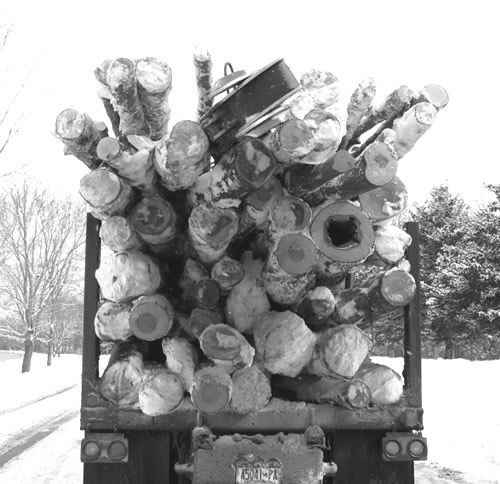
Some stacks may be made up of both shortwood and longwood. Any stack that includes shortwood must follow the shortwood securement requirements.
Exception: If shortwood is embedded in load of longwood, it can be treated as longwood.
Cargo is contained when:
- It is loaded on the end of the truck.
- it fills a sided vehicle, and every article is in contact with or sufficiently close to a wall or other articles so that it cannot shift or tip if those other articles are also unable to shift or tip.
- It fills a void between articles of cargo and the structure of the vehicle that has sufficient strength to prevent movement of the articles of cargo.
- It is packed in a square box.
Contained:
Cargo is contained if it fills a sided vehicle, and every article is in contact with or sufficiently close to a wall or other articles so that it cannot shift or tip if those other articles are also unable to shift or tip.
If the cargo is fully contained in a sided vehicle, what is the minimum requirement for withstanding sideways force?
- 0.2g (20% of cargo weight)
- 0.7g (70% of cargo weight)
- 0.5g (50% of cargo weight)
- 0.8g (80% of cargo weight)
Note: If the cargo is contained in a sided vehicle, the vehicle structure MUST be strong enough to withstand the forces described earlier.
- Forward force: 0.8 g (80%)
- Rearward force: 0.5.g (50%)
- Sideways force: 0.5 g (50%)
If you were instructed to 'tarp' a load, what would you be using?
- A waterproof sheet used to cover cargo.
- A platform or tray on which cargo is placed so that it can be handled as an article.
- A strip of material that may be used to unitize articles and is tensioned and clamped or crimped back upon itself.
- A short piece of material, usually wood, nailed to the deck to reinforce blocking.
Tarp:
A waterproof sheet used to cover cargo.
Who is responsible for inspecting securing devices and cargo within the first 50 miles?
- The driver.
- The D.O.T.
- Your Moms.
- The shipper.
Inspect Cargo and Securing devices:
- Pre-Trip: Yes
- Within first 50 mi: Yes
- When duty status of driver changes: Yes
- At 3 hour intervals or every 150 mi, whichever is first: Yes
When using tiedowns to secure boulders, all of the following are requirements except:
- Use only chain to secure large boulders.
- Tiedowns must be arranged to prevent sliding across the rock surface.
- Tiedowns should be located in valleys or notches across the top of the boulder.
- Boulders must be loaded as far back towards the rear as possible.
Requirements
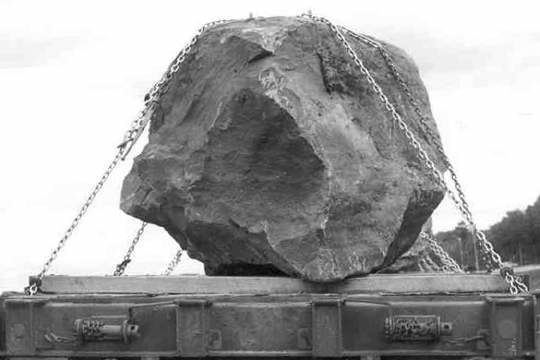
Use only chain to secure large boulders.
Tiedowns in direct contact with the boulder:
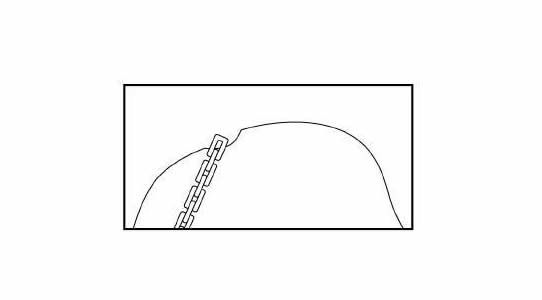
Should be located in valleys or notches across the top of the boulder
Must be arranged to prevent sliding across the rock surface.
In cargo securement, what is a 'cleat' defined as?
- A short piece of material, usually wood, nailed to the deck to reinforce blocking.
- Part of the structure, fitting, or attachment on a vehicle or cargo to which a tiedown is attached.
- A tapered or wedge-shaped piece used to secure round articles against rolling.
- A tapered piece of material, thick at one end and thin at the other.
Cleat:
A short piece of material, usually wood, nailed to the deck to reinforce blocking.
What is the maximum weight that can be secured by a tiedown with a marked WLL of 5,000 lbs?
- 10,000 lbs
- 2,500 lbs
- 6,000 lbs
- 5,000 lbs
Note: The minimum WLL requirement for the securement system is 50%. More tiedown capacity should be used if you need to secure an article against any movement.
A hook-lift container is:
- A specialized container, primarily used to contain and transport materials in the waste, recycling, construction/demolition, and scrap industries, which are used in conjunction with specialized vehicles, in which the container isloaded and unloaded onto a tilt frame body by an articulating hook-arm.
- The load carrying area of a truck, trailer, or intermodal container.
- A reusable, transportable enclosure that is especially designed with integral locking devices that secure it to a container chassis trailer to facilitate the efficient and bulk shipping and transfer of goods by, or between various modes of transport, such as highway, rail, sea, and air.
- A vehicle especially built and fitted with locking devices for the transport of intermodal containers.
Hook-lift Container:
A specialized container, primarily used to contain and transport materials in the waste, recycling, construction/demolition, and scrap industries, which are used in conjunction with specialized vehicles, in which the container isloaded and unloaded onto a tilt frame body by an articulating hook-arm.
When securing paper rolls with eyes vertical in a sided vehicle all of the following are acceptable except:
- Placing the rolls against each other.
- Placing rolls against the front and walls of the vehicle.
- Placing the rolls against other cargo.
- Placing rolls against the doors.
- Place paper rolls together in a group so that the structure of the group can be maintained.
- Place paper rolls against:
- The front and walls of the vehicle
- Each other
- Other cargo
About The Flatbed Cargo Securement CDL Manual
Studying the flatbed cargo securement CDL manual is not a requirement for getting your CDL permit or license. It is required knowledge for flatbed drivers.
Some questions you should be able to answer for flatbed cargo securement:
- What is the minimum Working Load Limit of a tiedown used to secure logs?
- What is the minimum weight of a shipment of paper rolls that would require specific securement requirements?
- When securing concrete pipe over 45 inches loaded crosswise, which direction must the tiedowns on the front half of the load run?
- What is a cab shield?
- When securing concrete pipe over 45 inches loaded crosswise, which direction must the tiedowns on the rear half of the load run?
- What is a dunnage bag?
- Who is responsible for inspecting securing devices and cargo within the first 50 miles?
- How many tiedowns are required on a stack of shortwood loaded crosswise?
- What is the minimum working load limit of each tiedown used to secure crushed or flattened vehicles?
- Define 'bolster'
- What is a hook-lift container?
- When a tiedown is attached directly to the cargo, what is the ideal angle where it attached to the vehicle?
What is a securing device?
Any device specifically manufactured to attach or secure cargo to a vehicle or trailer:
- Synthetic Webbing
- Chain
- Wire rope
- Manila rope
- Synthetic rope
- Steel strapping
- Clamps and latches
- Blocking
- Front-end structure
- Grab hooks
- Binders
- Shackles
- Winches
- Stake pockets
- D-rings
- Webbing ratchet
- Bracing
- Friction mat
What is a tiedown?
A combination of securing devices that forms an assembly that:
- Attaches cargo to, or restrains cargo on a vehicle.
- Is attached to anchor point(s).
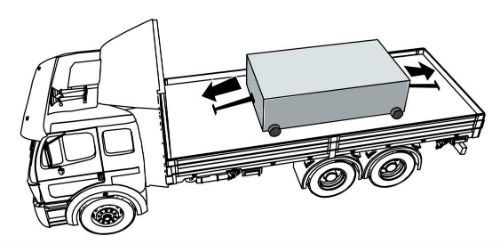
Some tiedowns are attached to the cargo and provide direct resistance to restrain the cargo from movement.
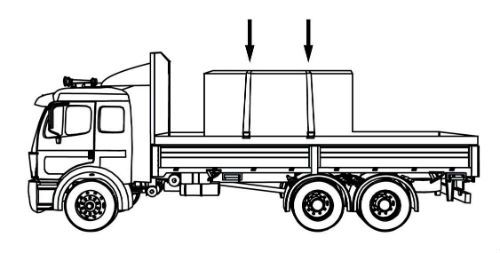
Some tie-downs pass over or through the cargo. They create a downward force that increases the effect of friction between the cargo and the deck. This friction restrains the cargo.
 Related Cargo Securement Terms That Every Driver Should Know:
Related Cargo Securement Terms That Every Driver Should Know:
-
Tiedown:
A combination of securing devices which form an assembly that attaches cargo to, or restrains cargo on, a vehicle or trailer, and is attached to anchor point(s).
-
Contained:
Cargo is contained if it fills a sided vehicle, and every article is in contact with or sufficiently close to a wall or other articles so that it cannot shift or tip if those other articles are also unable to shift or tip.
-
Blocking:
A structure, device, or another substantial article placed against or around an article to prevent horizontal movement of the article.
How should tiedowns be attached?
Tiedowns can be used in two ways:
-
Attached to the cargo:
- Tiedowns attached to the vehicle and attached to the cargo.
- Tiedowns attached to the vehicle, pass through or aroundan article of cargo, and then are attached to the vehicle again.
-
Pass over the cargo:
- Tiedowns attached to the vehicle, passed over the cargo, and then attached to the vehicle again.
Tiedown placement:

Place the tiedown as close as possible to the spacer.
Position the tiedowns as symetrically as possible over the length of the article.

Position the tiedowns to preserve the integrity of the article.







 TT On Facebook
TT On Facebook